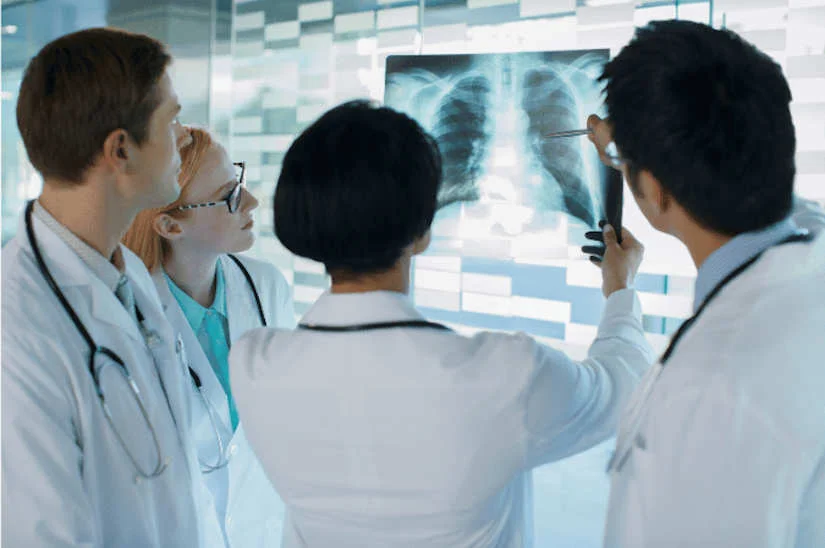The radioprotection is the set of measures, standards and practices aimed at protecting people, the environment and the surroundings from the harmful effects of ionizing radiation. In the clinical setting, the aim of radiation protection is to ensuring the safe use of radiation for diagnostic and therapeutic procedures for patients and healthcare personnel, minimizing the associated risks.
What is radioprotection?
The ionizing radiation is a fundamental tool in modern medicine. It is used in procedures of diagnostic imaging that use X-rays, such as conventional radiography, digital radiology, fluoroscopy, computed tomography (CT) and interventional radiologyRadiology, a branch of radiology that diagnoses and treats various pathologies by means of minimally invasive procedures. In turn, it is also used in radiotherapy treatmentsThe aim of this program is the destruction of tumor cells and tissues by means of radiation, and in the nuclear medicine.
However, its improper or excessive use can have harmful consequences for people's health.. These include tissue damage or increased risk of cancer in the long term. For this reason, it is of great importance in the clinical environment and requires a sound management. In this sense, the discipline of Radiation ProtectionThe company, which employs professionals such as physicists, physicians, biologists and engineers, is working to ensure that the development and application of technologies that use ionizing radiation are safe.
Basic principles of radiation protection
The Radiation Protection System is based on three fundamental principles that have been established by the International Commission on Radiological Protection (ICRP):
1. Justification
Any procedure involving the use of ionizing radiation must be medically indicated. This means that the benefits of the procedure must clearly outweigh the risks associated with radiological exposure.
2. Optimization (ALARA Principle)
Exposure should be kept "as low as reasonably achievable". This principle is referred to as ALARA and ensures that the lowest dose necessary to obtain clinical results is used.
3. Dose limitation
Strict dose limits must be established to protect both healthcare personnel and patients, preventing exposure from exceeding levels considered safe. This principle is oriented to the protection of persons exposed to radiation sources.
Application of the Radiological Protection System in the clinical environment.
In the clinical environment, the Radiation Protection System is implemented through a structured approach that includes the following aspects:
Design and maintenance of installations
The rooms of X-raysCT scans, CT scans or TAC and radiotherapy must be equipped with adequate shielding that minimizes radiation scattering. In turn, it is essential to carry out periodic inspections to guarantee the correct functioning of medical equipment and that they do not emit an unnecessary dose of radiation.
Equipment quality control
The following must be implemented preventive maintenance and calibration programs to ensure that the equipment operates efficiently within the established limits. Another key aspect is incorporate advanced technologies that allow automatic adjustment of radiation doses according to the patient's characteristics. To this end, digital radiology medical equipment will make it possible to optimize the amount of radiation, increasing safety in the healthcare environment for both medical staff and patients.
Staff training
One of the strategies to promote radioprotection in the clinical setting is to to train health professionals on the safe use of medical equipment that emit ionizing waves and which, in turn, have knowledge of the three principles of radioprotection. In this way, through appropriate training, it will be possible to promote the development of a safety culture to ensure the application of good practices in daily work in the health sector.
Radiation protection measures
Radiation protection in the clinical environment is essential to ensure the safety of patients and healthcare personnel from the risks associated with ionizing radiation. To this end, various strategies and tools designed to minimize unnecessary exposure are implemented, respecting the principles of justification, optimization and dose limitation.
Protection of healthcare personnel
Personnel working in areas where ionizing radiation is used must be adequately protected to avoid cumulative exposure that may pose a long-term risk. Key measures include:
- Personal Protective Equipment (PPE)Professionals should wear leaded aprons, thyroid protectors, leaded goggles and gloves that are specifically designed to reduce direct exposure to radiation.
- Dose monitoringIt is mandatory for health personnel to record the amount of radiation accumulated. This monitoring ensures that the dose does not exceed the limits established by the regulations in force.
- Staff turnoverTo minimize exposure time, personnel rotation is organized in tasks involving the handling of radiation-emitting equipment. In this way, the exposure load is evenly distributed.
Conoce nuestros equipos de protección de 4D Médica
Patient protection
Patients should also be protected from unnecessary radiation exposure, especially considering that they are often exposed in a timely manner but with high doses in some diagnostic or therapeutic procedures. The most relevant measures are:
- CollimationIt is essential to limit the area of the body that is exposed to radiation by using collimation systems that focus the radiation beam only on the area of interest. This reduces the amount of tissue irradiated and thus the associated risks.
- Optimized protocolsModern equipment makes it possible to adjust the exposure parameters (such as energy and radiation time) according to the specific characteristics of each patient. This makes it possible to deliver a minimum dose without compromising the quality of the radiation dose. medical images or treatment.
- Repetition controlTo avoid unnecessary repetitions of radiological studies, it is essential that the staff is well trained and that the equipment is functioning optimally. This ensures that the images obtained are of diagnostic quality on the first attempt.
Signaling and delimitation of areas
Facilities using ionizing radiation must have proper signage and access control to protect those not involved in the procedures. These measures include:
- SignageVisible signs should be posted indicating radiological risk areas and exposure levels, warning people of the need to wear appropriate protection or to avoid entry.
- Delimitation of areasIonizing radiation: Access to areas where ionizing radiation is used should be restricted. Its use should be limited to authorized personnel, thus avoiding accidental exposure of third parties or the general public.
Conclusion
The radioprotection in the clinical environment es una responsabilidad compartida que requiere la colaboración de profesionales, pacientes y entidades reguladoras. Aplicar los principios y las medidas de protección no solo garantiza la seguridad, sino también mejora la calidad de la atención médica.
Si quieres obtener más información sobre equipos de protección u equipamientos de diagnóstico médico, puedes contactar con nosotros. Nuestro equipo de 4D te dará asesoramiento para buscar la mejor solución para tu clínica u hospital.
Bibliography
Clínica Universidad de Navarra (CUN). (n.d.). Radioprotection. Medical dictionary. Retrieved from https://www.cun.es/diccionario-medico/terminos/radioproteccion






